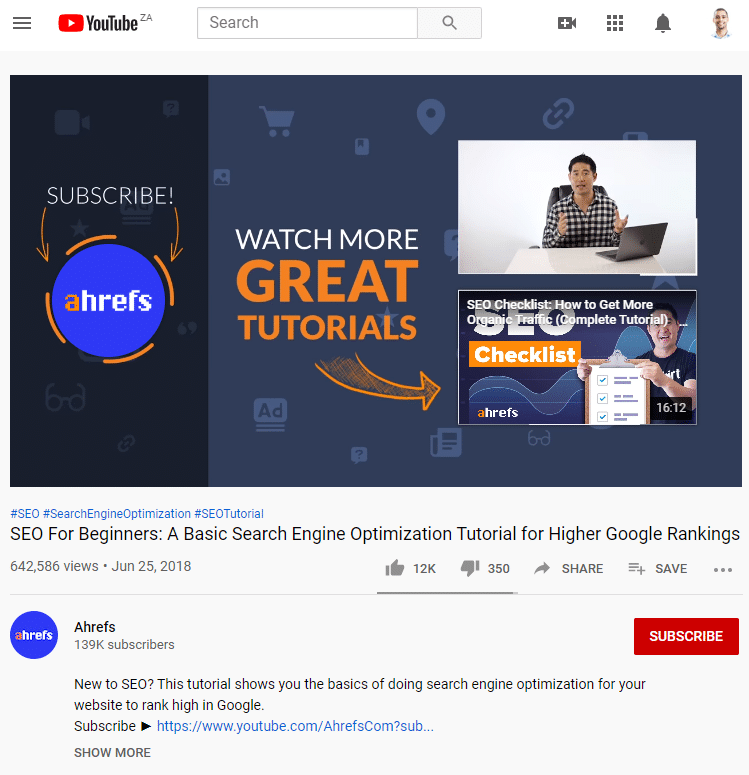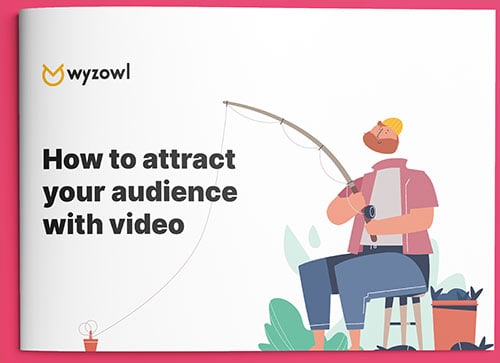Last updated on 14th November 2023
If your brand isn’t using video marketing today, you’re being left behind.
According to our Video Marketing Statistics 2023, 91% of businesses are using video as a marketing tool – with 17% of those marketers getting started with video in the past year.
As more brands turn to video to share the value of their solutions and grow, there’s a good chance that your competition is doing so, too.
Why does video matter?
Video is booming!
People consume it through social media and video-on-demand platforms and the numbers seem to point to greater and greater adoption. On average, people watch 17 hours of online video content per week.
Our interest in video isn’t all about cats and entertainment either, people use it to solve real problems. Google reports that four out of five people credit video for their acquisition of knowledge, while 90% of shoppers learned about new products through YouTube.
Stats and evidence aside, the real value of building a video marketing funnel is in understanding what it is and how it works.
What is a video marketing funnel?
A video marketing funnel is much like your content marketing funnel. In fact, it’s a funnel within your content marketing funnel.
A video marketing funnel guides your target audience all the way through the buyer’s journey.
It’s designed to attract, educate, convert, and retain buyers using videos at each stage.

Source: Wistia
Video funnels follow the same goals as your content marketing funnel, with KPIs tied to each stage.
For example, if your goal is to attract a larger audience, your videos need to target buyers who are at the start of their journey and trying to define and identify problems with top-of-funnel content.
Your main KPI would be video views that prove your content helpful and is being consumed by the right audience. You might also consider engagement metrics such as view time, and click through rate if you offer a call-to-action at the end of your video.
Why video marketing funnels are so effective
Video marketing funnels are capable of doing more to drive your marketing messaging than other forms of content because of the medium.
Video blends sound and visuals, two powerful tools for altering emotional states. For example, research by author David Heyrle into the effectiveness of visual design shows that 90% of people are visual learners.
And when it comes to sound, a study on the use of sound shows how it was able to influence the moods of crowds in public areas.
Put together, both findings are further validated by the University of California’s research into the field of advertising. They found that ads that can generate an emotional response do more to influence decision making than the actual content of an ad.
Whether your product is a video membership or subscription site or an eCommerce store, where text and images are successful at promoting your offer, video is far more engaging. As people absorb more visual information and experience altered emotional states through sound, their responses to well-structured videos can lead to better results for your brand.
What a video marketing funnel is made of
Most marketers understand the concept of a content marketing funnel but often struggle to understand how video marketing funnels work. So, we’ll dive a little deeper into what each stage of a video marketing funnel should look like. We’ll also save you a lot of time by sharing the key metrics to pay attention to at each stage.
ToFu: Attract your audience
The top of your funnel is where you create content about a specific problem or challenge that your buyer may be experiencing. Top-of-funnel content is designed to pull buyers in at the beginning of their journey. These are often people who are or have just become problem-aware but need a little more information to define what they’re going through before finding a solution.
At the top of your funnel, the key metrics to focus on are video view count and engagement. The more views and engagement you receive, the greater the chance that your message is reaching more of your audience.
Example: Grow better with Hubspot
Almost every marketer has heard about HubSpot. They offer quintessential tools for growth-focused brands. But in a world filled with a growing number of me-too marketing platforms, creating a message that resonates with your audience can be challenging.
To cut through the noise, HubSpot opted to go with something a little closer to home. Their video zeros-in on the biggest challenges that marketer’s face today.
It highlights the constant pressure to drive revenue above all else and counters it with an idea of a more compelling and humane approach to marketing and sales. If you’re a marketer who wants to generate results and feel proud about your work, this video was made for you.
Middle-of-funnel videos are designed to educate. As buyers move along their journey to finding a solution, they become more interested in what a solution might offer, and whether it addresses all of the problems they now clearly understand.
The key metric here is watch-time. As more people watch more of your videos, the greater the probability is of them learning about your solution and why it solves their problems or meets their needs.
Example: How to sell your phone on eBay
eBay was founded in September 1995. And while they are over 25 years old, they’re still focused on making sure people know how to use their platform. To help, they produced a short explainer video. It walks customers through the listing process for people wanting to sell their smartphones. While just 30 seconds long, eBay does a stellar job of simplifying how their platform works and makes customers feel empowered enough to sell their smartphones online.
BoFu: drive conversions through proof
Bottom-of-funnel videos are created to convert ready-to-commit audiences. At this stage in the buyer’s journey, your audience has a good understanding of the problems and challenges they face, knows about your solution (and likely host of competitive products), and is now weighing up their options.
Your goal at the bottom of your funnel is to help buyers do away with any lingering objections they may have towards your solution.
Your key metrics are conversions in the form of sign-ups, leads generated or sales.
Example: ConvertKit demo & tutorial
Finding email marketing software isn’t the toughest thing to do, but it can be hard to find the right solution. In ConvertKit’s demo and tutorial video, well-known online entrepreneur Pat Flynn walks viewers through the state of your marketing, reasons why ConvertKit is the best solution out there, and then shows how to use the platform.
Demo videos are critical bottom-of-funnel content and more so when they’re endorsed by well-known brands or public figures. And that’s what makes this video so powerful. Flynn leads with stats as he builds a case for email marketing software and ends with practical use in the form of a tutorial.
Retention: keep buyers happy and in your ecosystem
Retention videos are used to familiarise customers with your product. Through educational and instructional videos, your audience begins to explore all your product has to offer, making it easy to use and generate results with.
Create a SPLIT SCREEN Music Video in Filmora9
Filmora9 is free video editing software designed to be easy to use and understand by beginners. To help their audience learn how to use their software, Filmora produces tutorials on how to use the product. In this tutorial, users get to learn how to create a split-screen music video, an effect that’s growing in popularity on YouTube.
Key metrics in the retention stage are video views and watch-time. Together, these metrics show how popular your videos are and whether they help people.
How to build a video marketing funnel that converts
With a good understanding of each stage of the funnel, it’s time to look at how to build yours. Here’s a step-by-step process for creating an effective video marketing funnel.
Step One: Conduct an audit
Conducting an audit is always the best starting point when it comes to designing a video marketing funnel. Like all audits, the goal is to understand how effective your videos have been.
While audits can be complex, yours doesn’t have to be. If this is your first time working with video, reading this section is still worthwhile. It will help you develop a deeper understanding of what makes for an effective video funnel.
If you’re looking for ways to elevate your funnel, here are a few questions to ask yourself to establish how effective your video marketing has been thus far.
1. How many videos have you published and how successful have they been (according to key metrics shared for each stage of the funnel)?
2. What’s your major challenge?
Your major challenge is the one thing that seems to be preventing your funnel from producing results. The great news is that the funnel works in stages and in sequence. It cannot be broken. This means if you’re struggling to attract viewers, you shouldn’t be focusing on creating BoFu content.
Questions to ask include:
- Are you generating enough video views (ToFu)?
- Are your educational videos getting enough watch-time (MoFu)?
- Are you collecting more leads and sign-up or generating more sales (BoFu)?
- Are you getting enough views and watch-time on tutorials and instructional videos (Retention)?
It’s possible to answer yes to all the above, and if that is your situation, start at the top of your funnel.
IMPORTANT: to convert more customers, you must start with one major challenge. Challenges must follow the sequence of the funnel. For example, if you’re selling a course on how to host and create live events, you can’t drive sales without attracting more viewers and educating them first.
Step two: Plug the hole
Having identified your major challenge, generate content ideas that align with your audience.
Use personas
First, lean into your personas. Get very clear on who they are, what their challenges, needs and problems are, what matters most to them along their journey, and what values they hold dear.
While stats and figures point to how effective your strategy and content will be, your strategy is ultimately influenced by how well you understand your audience.
Find your competition
Check out the competition and what works for them. Look at the engagement they receive on social media and YouTube, and see what works with your audience for ideas of what you can create, too.
Plan your videos
With a good understanding of who you’re creating content for, it’s time to figure out what content you need to produce. Having done the work in step one, the audit should show where your funnel needs attention.
Pro tip: if you find that your audience is small or you don’t seem to be getting as many views as you need, you have a ToFu challenge. You need to create more content to attract a larger audience. Once you created enough top-of-funnel video content, then proceed to produce more MoFu content.
Is there a secret ratio that you can apply?
We’ve seen that creating a 60% (ToFu) and 40% (MoFu) split works effectively to start with. By producing more ToFu content you’re able to reach a wider audience, one that will move as many viewers down your funnel as possible. Once you get traction, start stretching that ratio to include BoFu content, but always have more ToFu and MoFu content.
Step three: Get creative
Coming up with great ideas for your videos isn’t always the easiest thing to do, but the process can be simplified. It’s all about creating a clear picture of what your audience stands to gain by watching your videos. By leveraging knowledge of your buyer personas, and what they want most, you are able to tap into stronger and more effective creative ideas.
How?
Think in before and after states
Before and after states are a look at the life of your buyer before and after they’ve watched your video. By identifying your audience’s before and after states, you’ll be able to create material that resonates with them.
For example, let’s say you’re creating a video about how video demonetisation works on YouTube. Highlighting a pain point (lack of income) as a before state, and how watching your video relieves viewers (shows how to prevent income loss) as an after state, would work well.
DigitalMarketer introduced the Before and After Grid as a simple solution to creating effective marketing messaging.

Image: DigitalMarketer
Be a world-class host
While inbound marketing is no longer a new concept, the idea of offering value is stronger today than ever before. And for brands looking to leverage video marketing, the need to show your audience that you really get them and know how to solve their problems is essential.
As you create videos, think of yourself as a world-class host. Serve your audience by offering value that exceeds their wildest expectations.
And value doesn’t have to be hard to share. It can be communicated by offering clearer examples in videos, or giving information that buyers would not easily find. While these may appear as small gestures, they make your brand more endearing and strengthen your competitive advantage.
Always share what happens next
People love journeys. To drive results with your video marketing funnel, you’ll have to connect the dots for viewers. This means including effective calls to action to promote your site and products, guiding people along to the next step in their journey.
Here’s a simple three-step formula for creating powerful calls to action:
- Make it personal by using messaging that’s relevant to your audience.
- Clearly communicate the benefit of taking action by sharing what your audience stands to gain by downloading your guide or visiting a page.
- Use action-oriented language to motivate a reaction.
Ahrefs shows how easy it is to create a powerful call to action. In the final seconds of their video on SEO for beginners, host Sam Oh tells viewers that there are many more videos to watch (with links in the description).
The end screen also includes a visual that reinforces Sam’s message. Altogether, this call to action is personalised for viewers who want to learn more about SEO. By offering more great tutorials to this audience, Ahrefs checks all the boxes with this video.

Conclusion
This is the best time to invest in your very own video marketing funnel. Video is only going to become more popular, and your brand can’t risk being drowned out by competitors who use effective video marketing.
While the idea of committing to video may seem overwhelming, all it takes is little planning and creativity. As you create your video marketing funnel, remember that video is like every other piece of content in your funnel. It must be designed with purpose and tracked with relevant metrics.
This post was written by Amir Shahzeidi
Amir is the digital marketing manager at Uscreen, an all-in-one video monetisation and OTT platform provider that empowers video entrepreneurs and creators to monetise their content and build thriving businesses around their videos.






